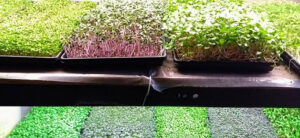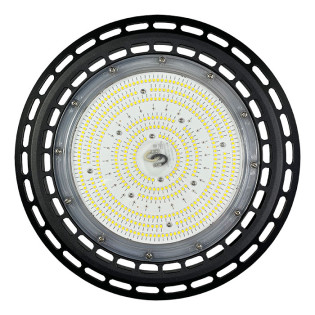
Growing microgreens hydroponically is a great, unique way to cultivate a culinary essential indoors.
Growing this plant in soil in the garden is a great option too, of course, but once you learn the advantages and benefits of going the hydroponic route, you'll see why so many opt for this approach instead.
Not only will you be able to grow a large amount of food in a small amount of space, but you can do so regardless of your climate, the time you have available, or your skill level.
We're going to have you growing hydroponic microgreens in no time, after we teach you all about why you should try it and how you can get started.
At the end of this article, we'll share with you the best system to use for your garden, but let's start by explaining what microgreens even are!
What Are Microgreens?
Microgreens are the seedlings of edible vegetables and herbs that are harvested before they reach the adult stage of their growth.
Why harvest so early? For one, the seedlings have an excellent flavor and texture.
Microgreens came into vogue in the 1980s, when chefs started to look for alternative ways to spice up their dishes without having to spend a ton of money.
Today, you’ll find microgreens garnishing the plates of most restaurant dishes, as well as those that you might prepare in your own home.
Why Do People Love Microgreens So Much?
One of the biggest benefits of using microgreens is that they carry a huge punch of flavor. They’re known for packing a ton of flavor into a very small serving. Want to add a gorgeous finishing touch to a salad?
Spice to a dish? Microgreens can do the trick. Another benefit of microgreens is that they can be grown year-round for very little money.
Since they’re ready for harvest in anywhere between six and fourteen days, you can grow these delicious little flavor bombs repeatedly in your home - no matter where you live.
What Are The Best Microgreens To Grow Hydroponically?
Some of the best microgreens you can grow are actually best grown hydroponically.
With a short time to harvest and plenty of flavor and nutritional value, some of the best options include clover, radishes, alfalfa, collards, kale and kohlrabi.
Out of the six microgreens stated above, four of them are considered to be some of the healthiest microgreens you grow and eat, with clover, radishes, kale, and alfalfa taking center stage.
Of course, you can grow just about any kind of microgreen hydroponically, so feel free to experiment. Some other good options include beets, carrots, and basil.
Why Should I Try Growing Microgreens Hydroponically vs In Soil?

There are many advantages to growing microgreens hydroponically as opposed to growing them in soil.
For example, this growing strategy often yields faster harvest times than does planting directly in soil.
The reason for this is that hydroponically grown greens receive their nutrients directly from the growing media rather than having to absorb them through their roots in the soil.
Because soil-grown microgreens have to sort through nutrients in the soil and process them through their roots, it can take them longer to receive their nutrients.
Another benefit to growing microgreens hydroponically? You can grow them anywhere, no matter where you live. You don’t have to have a balcony or window sill with natural sunlight. All you need is some quality indoor lighting or a grow light with a timer.
In addition, you’ll find that most microgreens get a majority of their nutrients from the pH-balanced water solution.
What Exactly Is Hydroponics?
To make it simple, hydroponics is the art of growing food without the soil. With hydroponics, you skip the soil, instead of utilizing just freshwater with a balanced pH (usually around 6 to 6.5), oxygen, root support (you'll use something like vermiculite or peat moss), nutrients, and light.
Benefits Of Growing Microgreens Hydroponically
There are many benefits of hydroponics microgreens. A few of the obvious benefits are the facts that you don’t need to grow these greens with soil, you use less water, and you don’t need a bunch of light.
One of the biggest benefits of growing microgreens hydroponically is location.
When growing greens hydroponically, you have the option to grow your micros wherever you desire without having to worry about tilling the soil, adding nutrients with compost or synthetic fertilizers, or dealing with the weather.
Hydroponic growing also allows for easy troubleshooting. Since there are fewer variables involved in your grow set-up, it will be easier for you to pinpoint problems when things go wrong.
How To Get Started Growing Microgreens Hydroponically
Now, we are going to teach you how to grow microgreens hydroponically. We’ll explain everything you need to know, including how to actually care for these delicate little plants. We’re going to start by explaining what you’ll need, though.
What Is Needed To Start Growing Microgreens Hydroponically?

When it comes to setting up your own hydroponics system to start growing your own greens, you don’t need much, just a few essentials.
Although you can certainly invest in more expensive hydroponic set-ups, as a beginner, there are very few things you actually need to get started.
First and foremost is fresh water. The water needs to be pH-balanced and contain appropriate amounts of calcium, magnesium, and phosphorus.
Since the water and nutrient blend will be your plants’ sole source of nutrients, it’s essential that you get this part right. You will also need oxygen. A decent air pump and air stone will work just fine.
After that, you’ll need to find some good root support. Since you won’t be using soil to ground the roots of your microgreens, you’ll need to find a hydroponic grow media.
Potential root support materials could be coco coir or rockwool. Don’t use anti-moisture substrates like gravel or sand, as these could clog your system and lead to further problems.
Next, you’ll need light! Since you’re growing your plants indoors where natural lighting may be limited, investing in a grow light would be beneficial.
You can still supplement with natural lighting when you can, but a grow light can be set up on a timer to make your life a bit easier. For microgreens, just a fluorescent or small LED grow light will be perfect - these plants don't need ultra-intense light.
Choosing Seeds vs Cuttings

Microgreens are unique in that they will regrow several times after being cut. As a result, you can get multiple harvests from one set of seeds.
After they’ve stopped growing, you can just empty the contents of your tray into the compost.
When you’re first getting started with growing microgreens hydroponically, it might be easiest to start with seeds. Then, you can reuse the cuttings later on to fuel additional batches of microgreens.
One thing to bear in mind is that you will need to leave a bit of stem each time you cut - and that the second, third, or any other subsequent batch of microgreens won’t be as flavorful as that first initial batch.
Hydroponic Microgreens Care & Grow Tips
On a day-to-day basis, you want to make sure your microgreens are getting sufficient water, light, and even periods of darkness.
Check-in on your microgreens every twelve hours or so to make sure they are growing properly.
If they are wilting, chances are it’s because you are watering them too little. If they’re rotting, you are likely overwatering.
Test the pH balance of your water often. You should also inspect your trays often. If they start to mold, you may have planted your microgreens too thick (or, again, be watering too much).
When you plant your seeds, pay close attention to the depths at which they should be planted. Read instructions carefully, as this will tell you the proper depth and air system necessary for growing your microgreens.
Which Systems Are Best For Growing Microgreens Hydroponically?
Now, you may be wondering which hydroponic system you should get started with.
We have an article on the best hydroponic systems of the year, but a lot of the systems you’ll find on their aren’t necessarily well suited for this type of plant.
You’ll want a smaller setup if you're a hobbyist just looking to add some flavor to the dinner table.
But if you're a commercial grower, you'll want to consider a flood and drain setup. Here are some great options, available right here at Hydrobuilder.com.
Hydroponic Microgardens

If you're a hobbyist, a hydroponic microgarden system is perfect for growing microgreens hydroponically.
These are just small hydroponic systems, geared towards tiny crops like microgreens. The SunBlaster Grow Light Gardens are one such option, available in six different sizes for whatever quantity of plants you're hoping to grow.
What's great about these is they include a grow light too, so all you need to add is the nutrients and water! The system is completely automated, using a wick style to keep the plants doused in a nutrient-rich solution at all times.
This is perfect for growing on a desk in your room, or even on the kitchen counter. All you need to do is choose your seeds, put it together, and enjoy a harvest of delicious microgreens down the road!
Another great choice is the Hydrofarm MegaGarden. Because this option doesn't come with a light, you'll either need to place this system in the windowsill or grab a fluorescent grow light to illuminate your microgreens.
Ebb & Flow Systems (Best For Commercial Growers)

If you are looking to try growing microgreens hydroponically on a commercial scale, you won't want to use a microgarden.
Instead, consider an ebb and flow system. These are also known as flood and drain systems, and consist of a grow tray and stand, reservoir, water pump/air pump, and pots/grow media to grow your microgreens in.
One great option for those who are serious about this is the Sananbio Radix S-Vertical grow kit. Its a rack system, so you can get the most out of your expensive grow space. It includes LED lighting built into the racks, making this a plug and play system.
We also carry more budget-friendly options, such as the Active Aqua or the Botanicare ebb & flow kits.
FAQs Regarding Growing Microgreens Hydroponically
We know you likely still have questions about growing microgreens hydroponically, but don’t worry - we have answers!
Here are some of the most common questions growers ask us regarding this topic.
Do microgreens regrow after cutting?
Some microgreens do regrow after cutting. As stated earlier, salad microgreens can regrow after their first harvest.
Just remember to reserve a bit of space on your stems so they can still regrow. They won’t taste as flavorful the second time around, but they will still be delectable and nutritious nonetheless.
Do you need fertilizer when growing microgreens hydroponically?
You do not need to add supplemental fertilizer when you are growing microgreens hydroponically.
Everything your plants need will be supplied via the nutrient solution you use to water your plants.
Is it better to grow microgreens in soil or water (hydroponically)?
There are many benefits of growing your microgreens hydroponically as opposed to soil. If you are growing in an urban environment, hydroponics is the way to go.
If you are growing in a rural area, soil growing might be best if you are pressed financially and don’t want to invest the (minimal) amount of money it takes to get a hydroponics system up and running.
Are microgreens actually healthy?
Although it will take a lot of microgreens to fill you up at dinner time, they are incredibly healthy. Greens like kale, alfalfa, and radish are just a few of the healthy microgreen options available to you.
How many hours of light do microgreens need?
The amount of light needed by your microgreens will vary depending on what kind of greens you are attempting to grow.
In general, most microgreens need about 12 hours of light and 12 hours of darkness in order to thrive.
Can microgreens grow to full size when grown hydroponically?
Yes, but they won’t be microgreens. You can continue to grow microgreens so that they reach their “full potential” and become adult plants, but you will need to allot enough space, time, and nutrients for you to do so.
Final Thoughts On Growing Microgreens Hydroponically
Now that you have some tips, tricks and information, you’re ready to get your own hydroponic system setup.
You’re one step closer to miniature greens with maximum flavor! Here at Hydrobuilder, we have everything you need to grow microgreens (and everything else, for that matter) hydroponically or aquaponically.
Shop our selection of products, from nutrients to ebb and flow systems, to get the best deals and service around.






























